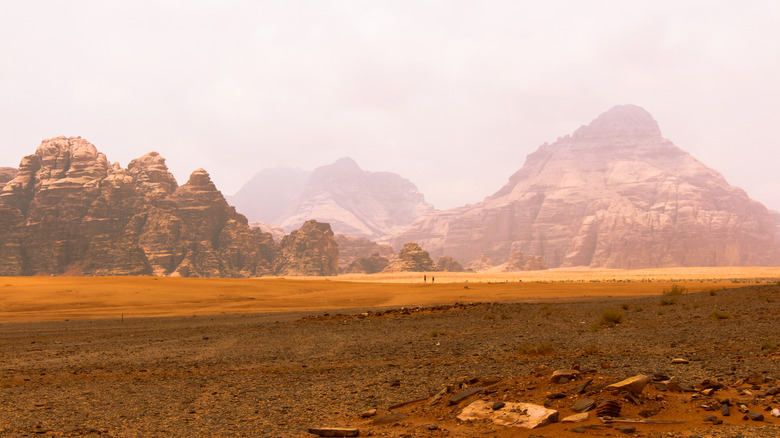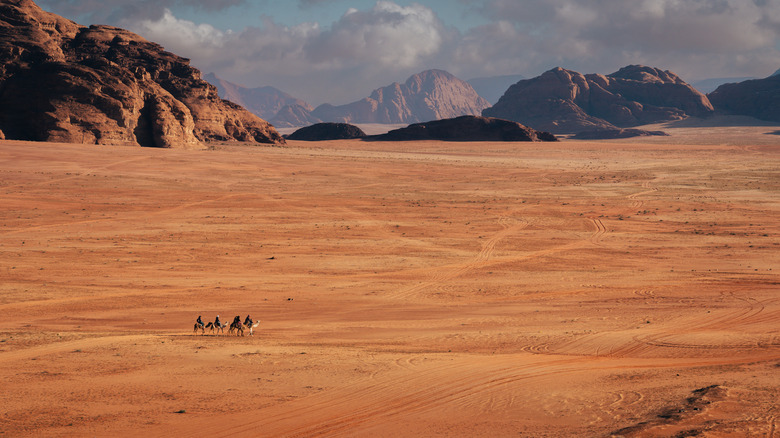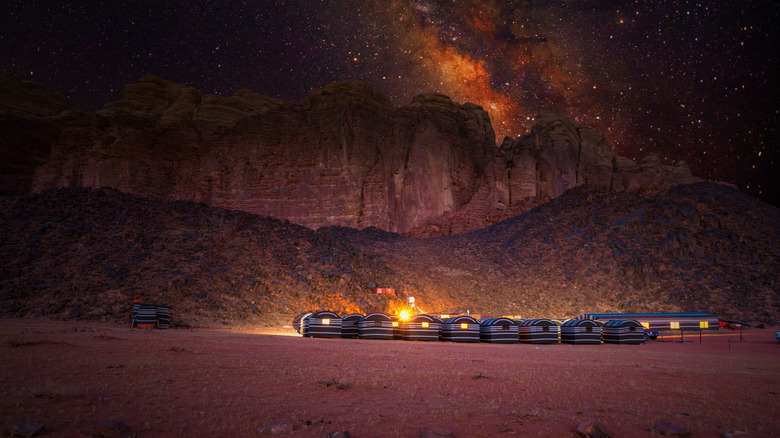Surround Yourself In Diverse Desert Landscapes At This Otherworldly Middle Eastern Destination
Smothering southern Jordan, the vast Wadi Rum Protected Area epitomizes an Arabian desert scene. It's utterly silent, where the faint moans of a camel or a car careening over loose sands carry miles on the wind, and barren, void of greenery that thrives beyond the stage of a thorny shrub. The area is an elusive escape, and its tribal inhabitants live their full lives in the heart of the desert. The only features obscuring the horizon are sandstone monoliths run with rust red veins. Jutting from the cusps of golden dunes, sparse shrubbery cling to their crags like the only soaring buoys in an ocean of sand. Twisted into archways, hewn into slim gorges by long barren rivers, gouged by cavernous caves, and stacked towards the sky, these unique rocks transform the Wadi Rum into a sandscape unlike any other.
Roughly 12,000 years of desert dwellers have left their mark on their home, with painted petroglyphs, ancient inscriptions still donning the rock walls, the direct ancestors of the Bedouin tribes that inhabit the area today. Historically, these nomadic tribes traversed the deserts of Mesopotamia, the Levant, and the Arabian Peninsula, guided by the stars and transported on camelback. Today, most young Bedouins are more settled in camps within the Wadi Rum. Many of them host travelers, inviting outsiders to learn about their ancient culture and the glorious sweep of sand that they call home. Most visitors tack on a trip to the Wadi Rum after visiting Petra, Jordan's premiere attraction and one of seven destinations considered wonders of the world.
Explore otherworldly landscapes on a Wadi Rum day tour
While the Wadi Rum's engulfing sands stretch southwards, merging into the desert of Saudi Arabia, the designated protected area conserves the region's most unique topographical marvels. Arriving in the wadi (valley) after journeying from the capital of Amman, the heritage site of Petra, or the port city of Aqaba, arrange to immediately set out on an adventurous tour of the desert.
The most common modes of transport in the Wadi Rum are Jeep and camel, and you can arrange to take your tour with either. Jeep tours cover more ground, with expert desert drivers navigating over the dunes, while roaming the sands on camelback adds to the authenticity of the remote desert experience. Both options will carry you out to Ain Abu Aineh, a spring marked with Thamudic inscriptions, evidence that travelers have sought refuge at its waters for thousands of years. You'll move onwards to the Red Sand Dune, tinted by iron oxide, and the narrow petroglyph-painted passageways of the Khazali Canyon. Your tour will continue on under stacked stone archways to a 2000-year-old Nabataean caravanserai now named Lawrence's House, ever since Lawrence of Arabia allegedly sought shelter in its walls.
Hikers undeterred by the scorching heat have the chance to top Jordan's tallest mountain, Jabal Umm ad Dami, to watch the sun sink into the sands from panoramic heights. Or vista-seekers not inspired by the 113-degree-Fahrenheit heats can book a hot air balloon tour to float over the desert's towering stones.
Learn about desert culture during a stay in a Bedouin camp
Silhouetted against the sand-hazed horizon, solitary Bedouins cast elongated shadows over the dunes. A people whose culture predates the biblical tales their nation is famed for, whose practices have stayed steadfastly unchanged for millennia, the Bedouin are intensely proud of their culture. Stay in the traditional Hasan Zawaideh Camp for an opportunity to camp in luxury and explore sand dunes, where visitors are invited to sit cross-legged by the fire for nightly teas and nomadic tales.
After a long day of traversing the dunes, the valleys, and the ochre crag, travelers mingle with tribesmen around the campfire. Dinner is pulled each night from a subterranean oven, in which the maqluba (a traditional dish of lamb or chicken and rice) has been left to simmer in its spices under the beating sun. Though typically eaten with your yogurt-coated right hand while squatting around a communal plate, guests can opt out of that particular tradition.
After sampling the staple of Bedouin cuisine, you'll lay out on pillows woven in the geometric Al Sadu style, waiting for the sky to put on its nightly show. With the campfire throwing a bronze tinge over their keffiyeh-wrapped faces, your Bedouin hosts will regale their guests with stories of their families' migratory movements, guided solely by the light of the stars. The Milky Way descends most nights over camp, illuminating each rivet in the rocks that encase the Wadi Rum.


